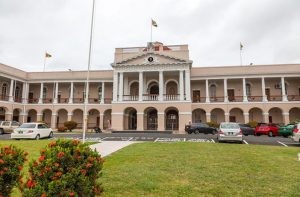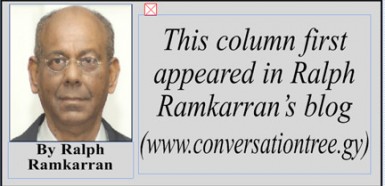West Indies Cricket Fans Forum
--
Cheddi Jagan’s contribution to Guyana’s Independence

Inspired by events that were occurring in the wider world and influenced by progressive views while he was a student in the United States, Dr Cheddi Jagan returned to Guyana in 1943, then British Guiana, intent on becoming politically involved on behalf of the poor and disadvantaged. He chose the trade union movement as an entrance point. Ashton Chase and Jocelyn Hubbard, both trade unionists, were sought out to join with him and Janet Jagan to form the Political Affairs Committee (PAC) on November 6, 1946, as a study and discussion group. Branches emerged in various places including Kitty, Buxton and Enmore. My father, Boysie Ramkarran, joined the Kitty Group in 1947. Ashton Chase, at the 50th Anniversary celebrations of the PAC said that my father was the Secretary of that group. Eusi Kwayana was active in the Buxton group.
 Amidst unrest and great and increasing poverty in the Caribbean in the 1930s and 1940s due to the Great Depression and drop in the price for sugar, the bauxite workers went on a long strike in 1947. In 1948 the successful Teare strike of transport workers took place followed by the Enmore strike of sugar workers. Having already won a seat in the Legislative Council in 1947, these events, and in particular the Enmore strike, motivated Cheddi Jagan to speed up the establishment of a political movement to struggle for universal adult suffrage, social justice and independence.
Amidst unrest and great and increasing poverty in the Caribbean in the 1930s and 1940s due to the Great Depression and drop in the price for sugar, the bauxite workers went on a long strike in 1947. In 1948 the successful Teare strike of transport workers took place followed by the Enmore strike of sugar workers. Having already won a seat in the Legislative Council in 1947, these events, and in particular the Enmore strike, motivated Cheddi Jagan to speed up the establishment of a political movement to struggle for universal adult suffrage, social justice and independence.
PAC’s internal discussions and consultations designated Cheddi Jagan as the Leader and Ashton Chase as the Chairman of the new party. Chase was General Secretary of the British Guiana Labour Union led by Hubert Nathaniel Critchlow. Billy Strachan, a Jamaican-British activist of the Caribbean Labour Congress and the West Indian Students’ Union, both in the UK, with whom Jagan was in touch, recommended Forbes Burnham as potentially having more appeal as Chairman because he had just qualified as a lawyer. The PPP was formed on January 1, 1950, after awaiting Burnham’s return and his brief sojourn as a member of the League of Coloured Peoples.
The PAC, though small and of limited influence, challenged colonial rule. The PPP was the first major political institution to place Independence on its agenda. Its general council comprised the following persons: Cheddi Jagan, Forbes Burnham, H Aubrey Fraser, Clinton Wong, Janet Jagan, Sydney King, Ram Karran, Ashton Chase, Rudy Luck, Frank O Van Sertima, Ivan Cendrecourt, May Thompson, Hubert Critchlow, E Kennard, Theo Lee, Ulric Fingall, Jainarine Singh, Sheila La Taste, Joseph P Lachmansingh, Cecil Cambridge, Fred Bowman, and Pandit Siridhar Misir. These are the men and women who first conceived of an Independent Guyana and who delivered the first blow. Their names deserve honourable mention. Universal adult suffrage was won in 1953 and the PPP won the elections of that year.
Hysterical but unfounded fears of ‘communism’ caused Churchill’s British Conservative government to suspend the constitution four months after and restrict and/or imprison some of its most militant leaders. My father was imprisoned for six months in March 1954 for violating the emergency regulations by not reporting to the Kitty Police Station one morning due to illness. He was required to report every morning. For several years he was restricted to between Sparendaam and Lamaha Street and Vlissengen Road.
The elections of 1957 were won by the Jaganite PPP after the split in 1955. The section led by Forbes Burnham was later known as the Peoples’ National Congress (PNC). The British government granted self-government in 1961, after the PPP won the elections again, and agreed to set a date for Independence.
The Kennedy administration of the United States then intervened due, once again, to unfounded fears of ‘communism.’ By then the British Conservatives, reconciled to the formal end of colonialism, saw Jagan like other nationalist politicians in the colonial world, who came around to ‘reality’ after Independence and the real world of economic development faced them. But the Americans insisted and the British, as always, succumbed to American pressure.
Disturbances took place in 1962, 1963 and 1964 leaving a legacy of death, destruction and ethnic discord. The PNC argued that there must be new elections before Independence. According to plan, the British took Independence off the table until new elections were held in 1964 under a new electoral system designed to defeat the PPP. In 1964 a coalition government of the PNC and the right wing United Force took office. Independence was then granted on May 26, 1966.
On March 4, 2010, I wrote in celebration of a previous Independence Anniver-sary: “On May 26, 1966, Burnham, then Premier, was stunned by an unfamiliar act of forgiveness and generosity ‒ the appearance of Cheddi Jagan, no longer in power, at the National Park to celebrate with him Guyana’s new status as an independent country and the realization of his dream and pledge in 1949 at Enmore to devote himself to the liberation of Guyana. The now famous embrace between these two leaders, who have shaped so much of Guyana’s political consciousness, says nothing about Forbes Burnham, the victor, but everything about Cheddi Jagan, the vanquished.”
The promise of that embrace is yet to be fulfilled.
Guyana Diaspora Forum
We have a large database of Guyanese worldwide. Most of our readers are in the USA, Canada, and the UK. Our Blog and Newsletter would not only carry articles and videos on Guyana, but also other articles on a wide range of subjects that may be of interest to our readers in over 200 countries, many of them non-Guyanese We hope that you like our selections.
It is estimated that over one million Guyanese, when counting their dependents, live outside of Guyana. This exceeds the population of Guyana, which is now about 750,000. Many left early in the 50’s and 60’s while others went with the next wave in the 70’s and 80’s. The latest wave left over the last 20 years. This outflow of Guyanese, therefore, covers some three generations. This outflow still continues today, where over 80 % of U.G. graduates now leave after graduating. We hope this changes, and soon.
Guyanese, like most others, try to keep their culture and pass it on to their children and grandchildren. The problem has been that many Guyanese have not looked back, or if they did it was only fleetingly. This means that the younger generations and those who left at an early age know very little about Guyana since many have not visited the country. Also, if they do get information about Guyana, it is usually negative and thus the cycle of non-interest is cultivated.
This Guyana Diaspora Online Forum , along with its monthly newsletter, aims at bringing Guyanese together to support positive news, increase travel and tourism in Guyana and, in general, foster the birth of a new Guyana, which has already begun notwithstanding the negative news that grabs the headlines. As the editor and manager of the publication, I am committed to delivering Blog entries and Newsletters that are politically balanced, and focused on the positive ideas we wish to share and foster among Guyanese.
| ||||

